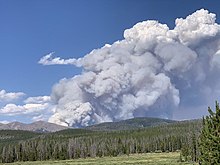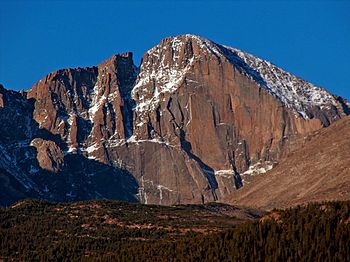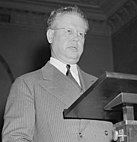Portal:Colorado
The Colorado Portal


WikiProject Colorado
You need not be either an expert or a resident.
You only need an active interest in the Centennial State.
Request an article about a Colorado topic here or volunteer here.
Colorado Events
- Wikimedia US Mountain West Spring 2024 online meeting, Tuesday, May 14, 2024, 8:00-9:00 PM MDT
- Wikimedia US Mountain West Summer 2024 online meeting, Tuesday, August 13, 2024, 8:00-9:00 PM MDT
- Wikimedia US Mountain West Autumn 2024 online meeting, Tuesday, November 12, 2024, 8:00-9:00 PM MST
Previous events:
|
|---|
Colorado events
|
Colorado Facts
- Date admitted to Union: August 1, 1876 (38th State)
- Demonym: Coloradan
- Capital: Denver
- Elected state officers:
- Governor: Jared Polis (D) (2019–)
- Lieutenant Governor: Dianne Primavera (D) (2019–)
- Secretary of State: Jena Griswold (D) (2019–)
- Treasurer: Dave Young (D) (2019–)
- Attorney General: Phil Weiser (D) (2019–)
- Colorado General Assembly:
- Colorado Senate:
- D-23 R-12 (2023–2024}
- Colorado House of Representatives:
- D-46 R-19 (2023–2024}
- Colorado Senate:
- Colorado Supreme Court:
- Brian Boatright, Chief Justice (2021–)
- Monica Márquez (2010-)
- William Hood, III (2014–)
- Richard Gabriel (2015–)
- Melissa Hart (2017–)
- Carlos Samour, Jr (2018–)
- Maria Berkenkotter (2021–)
- U.S. Senators:
- Class 2. John Hickenlooper (D) (2021–)
- Class 3. Michael Bennet (D) (2009–)
- 1. Diana DeGette (D) (1997–)
- 2. Joe Neguse (D) (2019–)
- 3. Lauren Boebert (R) (2021–2025)
- 4. vacant
- 5. Doug Lamborn (R) (2007–2025)
- 6. Jason Crow (D) (2019–)
- 7. Brittany Pettersen (D) (2023-)
- 8. Yadira Caraveo (D) (2023–)
- Total area: 104,094 square miles (269,602 km2) (eighth most extensive state)
- Highest elevation: Mount Elbert 14,440 feet (4,401.2 m) (third highest state)
- Mean elevation: 6,800 feet (2,070 m) (highest state)
- Lowest elevation: Arikaree River 3,317 feet (1,011 m) (highest state)
- Population (2020 census): 5,773,714 (21st most populous state)
- Population density: 55.47 per square mile (21.40 km−2) (39th most densely populated state)
- Number of counties: 64 counties (including two consolidated city and county governments)
- Number of municipalities: 273 municipalities, comprising 2 consolidated city and county governments, 73 cities, and 198 towns
- Time zone: MST=UTC−07, MDT=UTC−06
- USPS code: CO
- ISO 3166 code: US-CO
- Adjacent U.S. states: Wyoming, Nebraska, Kansas, Oklahoma, New Mexico, Arizona, Utah (tied for third most)
- State government website: Colorado.gov
- State tourism website: Colorado.com
State Symbols
Subcategories
The Colorado River (Spanish: Río Colorado) is one of the principal rivers (along with the Rio Grande) in the Southwestern United States and in northern Mexico. The 1,450-mile-long (2,330 km) river, the 5th longest in the United States, drains an expansive, arid watershed that encompasses parts of seven U.S. states and two Mexican states. The name Colorado derives from the Spanish language for "colored reddish" due to its heavy silt load. Starting in the central Rocky Mountains of Colorado, it flows generally southwest across the Colorado Plateau and through the Grand Canyon before reaching Lake Mead on the Arizona–Nevada border, where it turns south toward the international border. After entering Mexico, the Colorado approaches the mostly dry Colorado River Delta at the tip of the Gulf of California between Baja California and Sonora.
Known for its dramatic canyons, whitewater rapids, and eleven U.S. National Parks, the Colorado River and its tributaries are a vital source of water for 40 million people. An extensive system of dams, reservoirs, and aqueducts divert almost its entire flow for agricultural irrigation and urban water supply. Its large flow and steep gradient are used to generate hydroelectricity, meeting peaking power demands in much of the Intermountain West. Intensive water consumption has dried up the lower 100 miles (160 km) of the river, which has rarely reached the sea since the 1960s. (Full article...)Selected mountain -
Selected biography -
In 1938, after running unopposed in the Republican primary, Carr was elected to a two-year term as governor of Colorado, defeating Democrat Teller Ammons, the incumbent governor.[1][2]
A conservative Republican, Carr was committed to fiscal restraint in state government and opposed the New Deal policies of President Franklin Roosevelt.[3][4]
In July 1939, he joined 33 other governors is a statement calling for "moral rearmament" as a solution to the current economic crisis.[5] In August he sent the Colorado national guard to quell violence between AFL-organized strikers and non-strikers at the Green Mountain Dam construction site.[6] In late 1939, when he was mentioned as a possible Republican candidate for vice-president on the national ticket in 1940, he indicated he preferred to seek re-election as governor: "I am not interested in any job outside Colorado right now."[7] At the Republican National Convention in June 1940, Carr supported Wendell Willkie and seconded his nomination.[8]
Selected article -
Selected image -
National Parks in Colorado
The 23 national parks in Colorado:
- Amache National Historic Site
- Arapaho National Recreation Area
- Bent's Old Fort National Historic Site
- Black Canyon of the Gunnison National Park
- Browns Canyon National Monument
- Camp Hale-Continental Divide National Monument
- Canyons of the Ancients National Monument
- Chimney Rock National Monument
- Colorado National Monument
- Continental Divide National Scenic Trail
- Curecanti National Recreation Area
- Dinosaur National Monument
- Florissant Fossil Beds National Monument
- Great Sand Dunes National Park and Preserve
- Hovenweep National Monument
- Mesa Verde National Park and World Heritage Site
- Old Spanish National Historic Trail
- Pony Express National Historic Trail
- Rocky Mountain National Park
- Sand Creek Massacre National Historic Site
- Santa Fe National Historic Trail
- Yucca House National Monument
Interesting facts-

- On August 13, 2020, the Cameron Peak Fire ignited which would surpass the Pine Gulch Fire to become the most extensive wild fire in Colorado history.
- On March 13, 2020, a woman in El Paso County became the first person in Colorado to die from the COVID-19 virus.
- On July 31, 2020, lightning ignited the Pine Gulch Fire which would surpass the Hayman Fire of 2002 to become the most extensive wild fire in Colorado history.
- On October 14, 2020, the East Troublesome Fire ignited which would also surpass the Pine Gulch Fire to become the second most extensive wild fire in Colorado history. Experts say the onslaught of 2020 Colorado wild fires was aggravated by climate change.
- On December 30, 2021, the Marshall Fire killed two people and destroyed 1,084 homes and seven businesses and damaged another 149 homes and 40 businesses
- U.S. President James Buchanan signed the organic act creating the free Territory of Colorado on February 28, 1861.
- The Union Pacific Railroad was completed west to Julesburg on November 18, 1867.
- Deer Trail hosted the world's first organized rodeo on July 4, 1869.
- The first of what would become the Colorado State Fair opened in Pueblo on October 9, 1872, four years before Colorado became a state.
- U.S. President Ulysses Grant signed the presidential declaration admitting the State of Colorado to the Union on August 1, 1876.
- Katherine Lee Bates wrote America the Beautiful after a trip to the summit of Pikes Peak in the summer of 1893.
Did you know (auto-generated) -

- ... that Yemi Mobolade is the first Black person and the first non-Republican to be elected the mayor of Colorado Springs, Colorado?
- ... that the 1976 Big Thompson River flood took place several hours before Colorado's 100th anniversary of statehood?
- ... that the No. 1–ranked 2023 Colorado Mines Orediggers, "college football's nerdiest contender", featured players with pigtails and a drawn-on blue mustache, a friar's haircut, and Harry Potter cosplay?
- ... that Aymara legislator Rafael Quispe's humorous style of political activism led one Bolivian parliamentarian to describe him as the "Chapulín Colorado" of the Legislative Assembly?
- ... that some members of the Daughters of the American Revolution came up with the idea to design a flag of Colorado, unaware that such a flag already existed?
- ... that following the killing of Richard Ward by a Colorado sheriff's deputy, the deputy received an award for the injuries that he allegedly sustained during the incident?
- ... that Parkville lost out on becoming the Colorado Territory's capital by eleven votes and is now a ghost town largely buried under mining waste?
Related WikiProjects
Related portals
Resources
Associated Wikimedia
The following Wikimedia Foundation sister projects provide more on this subject:
-
Commons
Free media repository -
Wikibooks
Free textbooks and manuals -
Wikidata
Free knowledge base -
Wikinews
Free-content news -
Wikiquote
Collection of quotations -
Wikisource
Free-content library -
Wikiversity
Free learning tools -
Wikivoyage
Free travel guide -
Wiktionary
Dictionary and thesaurus
Collaboration
Topics
Sources
- ^ "Colorado is Carried by Carr, Republican" (PDF). New York Times. November 9, 1938. Retrieved February 20, 2017.
- ^ CO Governor Race - Nov 08, 1938. Our Campaigns. Retrieved September 12, 2021.
- ^ Ralph L. Carr. Colorado State Archives. Retrieved September 12, 2021.
- ^ February 4, 1941. Republican Governor Hits Proposed Western TVA. The Lantern via The Ohio State University. Retrieved September 12, 2021.
- ^ "34 Governors Ask Moral Rearming" (PDF). New York Times. July 18, 1939. Retrieved February 20, 2017.
- ^ "Men Resume Work on Colorado Dam" (PDF). August 5, 1939. Retrieved February 20, 2017.
- ^ "Carr Hints He Will Run" (PDF). New York Times. November 26, 1939. Retrieved February 20, 2017.
- ^ "Convention Opens". New York Times. June 25, 1940.























